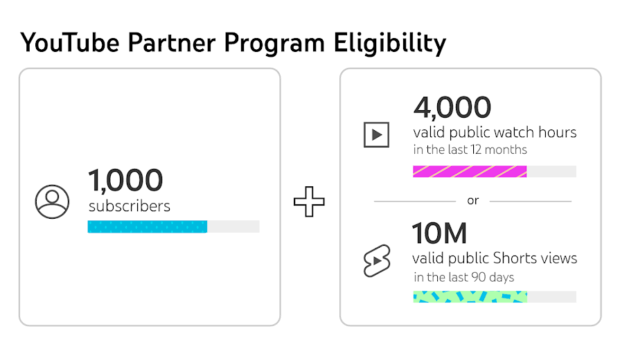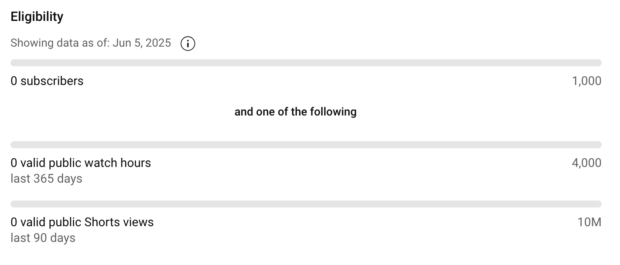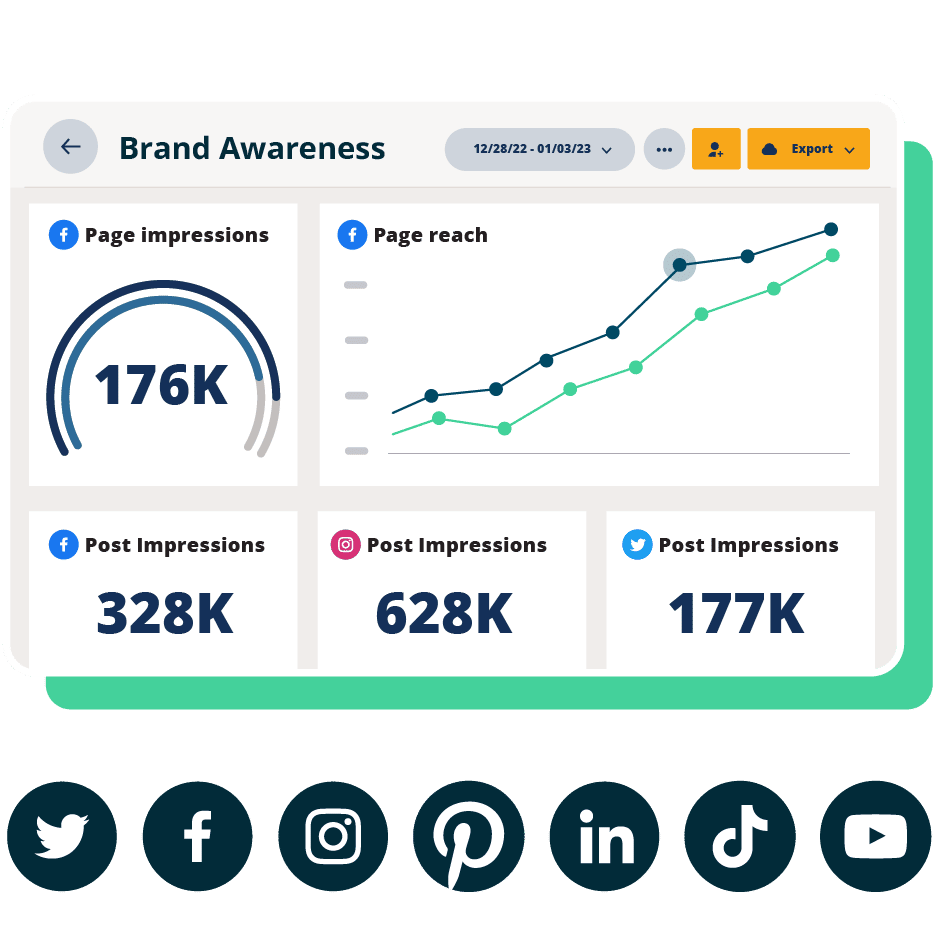If you, like thousands of other YouTubers, are hoping to make money on the video platform, you’re probably wondering what your income might look like. How much does YouTube pay per view?
The short of it is that YouTube pays each time someone views an ad, rather than a video. The video hosting platform takes 45% of what advertisers pay, giving the remaining 55% to the YouTube creator whose video displayed the ad.
But let’s get into the long of it, explaining in further detail how YouTube’s monetization system works so that you get a clear understanding of how you can make money on the platform.
How YouTube’s pay-per-view system works
Like we mentioned, YouTube does have a pay-per-view system, but it might not be what you’d initially think. Instead of getting paid for each video view, YouTubers are paid for each ad view.
Let’s dig a little deeper into what these two types of views mean:
- Video views are the number of views your video gets.
- Ad views are the amount of views ads on your video get.
YouTube pays you for the amount of ad views your video gets. If your video has a million views but no advertising on it, you won’t be making any money. If your video has a million views but only 10,000 ad views, you’ll be making money only on the 10,000 ad views.
Similarly, you might have multiple ads run within a single YouTube video. If users actually watch those ads all the way through, you could also end up with more ad views than video views.
Essentially, YouTube makes money off the advertising space, so they will only pay based on how much exposure your video generates for that advertising space. Make sense?
How do you become eligible for ad revenue on YouTube?
To keep it simple, you can become eligible to earn ad revenue on YouTube by joining the YouTube Partner Program (YPP). The YPP is how you can get YouTube money-per-view put into your pocket.
Pro tip: Be sure to get your YouTube account verified, too.
What you need to join the YPP
Want to join the YPP and start earning your own income? Follow this checklist of all items you need:
- Be compliant with the YouTube channel monetization policies.
- Live in a country/region where the YouTube Partner Program is available.
- Follow YouTube’s Community Guidelines because strikes on your channel will disqualify you.
- Turn on 2-Step Verification for your Google Account.
- Have advanced features access on YouTube.
- Either set up or have an active AdSense account you can link to your channel.
How to become eligible for the YPP
Once you’ve checked off each item on the above list, it’s time to look into eligibility requirements. You can become eligible to start making money from the YPP through both long-form videos and YouTube Shorts (or a mix) in either one of two ways:
- Gain 1,000 subscribers with 4,000 public watch hours in the last 12 months
OR
- Gain 1,000 subscribers with 10 million public Shorts views in the last 90 days.

Source: YouTube
If you’re ready to apply, we walk you through the YPP application process in this post.
8 factors that impact YouTube earnings per view
Not every ad view is worth the same amount of money. There are different factors that can impact how much YouTubers get paid for each view (if at all).
1. Content niche
Your video content niche can have a big impact on how much you’re able to make from ad revenue. This is because different niches have different ad costs, with some ad industries having a much higher CPM (cost per million impressions) or CPC (cost per click) than others.
In 2024, the most profitable YouTube niches by CPM were:
- Making money online: $13.52
- Digital marketing: $12.52
- Personal finance: $12.00
- Education: $9.89
- Tech, cars, & gadgets: $7.31
- ASMR: $3.50
- Lifestyle: $3.47
- Fashion: $3.13
- Beauty: $3.00
- Motivational: $2.50
- Cooking: $2.50
- Travel: $2.00
- Fitness: $1.60
- Gaming: $1.40
- Comedy: $1.00
Keep in mind that this is how much the advertiser pays. YouTubers then get a percentage of the ad’s CPM. But as you can see, the amount you’re able to bring in per view can fluctuate greatly depending on the type of content you publish.
2. Audience location
Your audience’s location can also factor into ad revenue. This is because different countries often have different CPM for advertisers.
The countries with the highest YouTube CPM are:
- Australia: $36.21
- United States: $32.75
- Canada: $29.15
- New Zealand: $28.15
- Switzerland: $23.13
- United Kingdom: $21.59
- Germany: $18.79
- Ireland: $18.20
- Singapore: $17.75
- Denmark: $17.49
So if your primary audience is watching from Australia or the United States, you’re going to be able to make more from your ad revenue than someone from a country with lower ad costs.
3. Ad type and placement
Different ad types and placements will also net different ad revenue. For example, advertisers have to pay premium rates for a non-skippable ad. If your audience is served this type of ad, you’ll make more than you would for a skippable ad.
4. Video length
Longer videos give you more opportunities for ads to run within your videos. The more ads that run in your videos, the more you’re likely to bring in.
Keep in mind that you can tell YouTube where you want ads to run within your videos. Set up ad slots at good stopping points within your video so the platform inputs them in between sections so they don’t interfere with the viewing experience.
However, just because you set ad slots doesn’t mean that YouTube will place ads during all of those slots. This is just a good way to tell the platform the best places for your ads to run.
5. Watch time
The longer people watch your videos, the more ads they’re likely to see. So, create engaging YouTube content that keeps people interested the entire time so you can boost your ad revenue.
6. Ad clicks
If someone clicks on an ad on your video, the advertiser pays more for that click than they would for the view. You’ll get the same portion of that CPC, meaning more money in your pocket.
7. YouTube Premium users
YouTube Premium users pay for an ad-free experience, so they won’t be shown ads if they watch your video content. Instead, you’ll be paid based on how many Premium users watch your videos and for how long they watch.
8. Some views don’t actually count
And finally, as unfortunate as it sounds, some ad views simply don’t count, and you won’t receive any YouTube revenue for them.
Those instances include:
- Skippable ads: Skippable ads can be skipped after the first five seconds. Which is nice for the viewer, but if the ad gets skipped, you don’t get paid. The only instance you’ll receive payment is if a viewer watches a skippable ad for 30 seconds or longer.
- Ad blockers: If a viewer is using an ad blocker, they won’t be shown ads, so you won’t receive any revenue.
- Demonetization: If a video you publish violates YouTube’s ad guidelines, it’ll be demonetized, meaning ads won’t play on it and you won’t be able to generate any revenue from it.
How much can you earn on YouTube in 2025?
So how much money can you actually earn on YouTube in 2025? Can you make a full-time job out of being a YouTuber?
The short answer is: Yes, you absolutely can! The longer answer is that the amount you make will depend on your subscribers, your video reach, and your video engagement. It also depends on how much you consider to be a full-time income.
In 2025, a YouTuber can earn anywhere from $5 to $15 per 1,000 ad views. YouTube ads see an average view rate of 49-68%, depending on factors like video ad type or creative.
Which means that a video with 10,000 views could have around 4,900-6,800 ad views. So on the lower end, this video could bring in around $25 up to around $100 on the higher end. For our purposes, let’s just meet in the middle and say a 10,000-view video brings in around $60.
If you publish one 10,000-view video per day, that’s a total of $21,900 in annual YouTube income, which is… not great in terms of a yearly salary.
But that’s only if you stayed stagnant. If you’re actually publishing new video content every day — or even once or twice a week — you should consistently see growth, boosting your views, your subscribers, and your ad revenue.
And as you continue to grow, you can turn to other monetization avenues as well.
How to set up YouTube monetization: A step-by-step guide
Want to start making money from your YouTube channel? Follow these steps to get started.
Step 1: Meet the YPP requirements
First things first, you need to make sure you meet all of the requirements for the YouTube Partner Program. We covered these earlier, but as a reminder, you need to:
- Create a Google AdSense account
- Turn on 2-step verification
- Follow community guidelines and monetization policies
- Verify your channel so you can get access to advanced features
- Grow your account until you reach monetization eligibility
To track your progress, head to YouTube Studio, then the Earn tab in the left sidebar. You can scroll down to see how you’re progressing along the YouTube Partner Program’s eligibility requirements.

Step 2: Apply for the YPP program
Once you meet the eligibility requirements, an Apply Now button will appear in the Earn section of your YouTube Studio where you were previously tracking your progress.
Follow the instructions in the application, then link your AdSense account so you can start earning once your application is approved.
Once you submit your application, you’ll be added into a review queue, and In Progress will appear in the Earn tab. You can check back to monitor the status of your application anytime, but it usually takes around a month to hear back.
As long as your channel complies with all relevant policies, you should get a positive response so you can start monetizing your video content.
Step 3: Enable monetization on eligible videos
Not every video will be eligible for monetization. The platform is pretty strict about its ad-friendly guidelines, ensuring that videos that run ads don’t include things like profanity, violence, adult content, controversial issues, or anything of that nature.
You’ll want to wait until each of your videos have been uploaded and reviewed to see if they’re eligible for monetization. You can then go into the Content area of YouTube Studio and turn on monetization for that video.
Step 4: Input ad slots on each video
Once you’ve turned on monetization, you can set manual ad slots for mid-roll ads within videos that are 8 minutes in length or longer. You can choose to only set manual ad slots, meaning you choose the best breaks in your videos for ads to run, only set automatic ad slots, so the YouTube platform decides the best places for ads, or a combination of both.
Step 5: Monitor your earnings
It takes two days for your income to show up in your analytics, but you can easily monitor your earnings in your YouTube Analytics dashboard or by logging into your AdSense account. Keep an eye on how much you’re bringing in and test different ways to earn more.

#1 Analytics Tool for Growth
Beautiful reports. Clear data. Actionable insights to help you grow faster.
3 expert tips to maximize YouTube earnings per view
Earn more from your ad revenue with these three tips.
1. Create long-form content
The longer your videos are, the more space you have for ads. Focus on creating long-form videos longer than eight minutes so you can add in mid-roll ads throughout your content.
2. Place more mid-roll ad slots
The more mid-roll ad slots you place, the more chances you have that YouTube will place ads within your longer videos, giving you even more earning potential.
In fact, a lot of YouTubers recommend inputting manual mid-roll ad slots every minute or so in your videos. YouTube won’t play ads during every manual ad slot you add in, but it could increase your ads and in turn, increase your revenue.
3. Focus on a profitable niche
We covered how ads in some niches cost more than ads in other niches. If you’re still choosing your channel’s focus, look at topics that have a higher ad CPM so that you can bring in more money from your ad revenue.
5 other ways to monetize your YouTube channel
Ad revenue isn’t the only way you can make money from YouTube. It’s important to diversify your revenue streams. On top of that, many content creators also make money from:
- Brand deals and sponsorships: Partner with brands to create sponsored videos, show off branded products or services, and more. Work with brands directly to come up with a rate per video.
- Channel memberships: YouTube has the option to create a paid membership for your exclusive subscribers who want to see more from your channel. Depending on the extra content you offer your members, you can charge a monthly rate of $0.99 up to $499.99. You keep 70% of each membership fee, and YouTube keeps the rest.
- Affiliate marketing: Promote products or services in your videos and include affiliate links in your YouTube description to earn a commission from anyone who purchases those products or services.
- Selling products: Create your own products, such as channel merch, digital products, a physical product line, or something else.
- Selling services: If offering a service makes more sense, this is another way you can use your YouTube channel to make money.
YouTube earnings FAQs
How much does YouTube pay per view?
YouTube’s ad revenue program pays per ad view, not per video view. This ends up sitting around $5-15 per 1,000 ad views, or around $0.005-0.015 per ad view.
How many views do I need to make money on YouTube?
To make money on YouTube, you first need to be eligible to join the YouTube Partner Program so that you can turn on monetization. To be eligible, you must have either 1,000 public watch hours on your long-form video content or 10 million YouTube Shorts views.
But once you’re monetized, you can make money from any ad views on your videos. However, to make a full-time income, you’ll probably want to see 10,000-100,000+ views on your content.
How much do you get paid per 1,000 views on YouTube?
You can typically expect to get paid between $5 and $15 for each 1,000 ad views your videos get.
How much does YouTube pay for 1 million views?
If your video receives 1 million views, going back to the math we did earlier based on the average ad view rate and average CPM, you might be able to expect around $2.5K to $10K.
Can you earn money on YouTube without ads?
Absolutely! You can still earn money on YouTube without ever monetizing your channel through the platform. Sell products or services, work with brands, create sponsored content, and more.
How do ad blockers affect earnings?
Ad blockers of course, keep your viewers from seeing ads. And if they’re not seeing ads, you’re not making any money.
Do YouTube Shorts pay well?
YouTube Shorts typically pay less than long-from video content as you get a lower RPM (revenue per 1,000 ad views). But they’re easier to make and you can publish more of them, which can still make this a viable way to earn ad revenue.
Let Hootsuite make growing your YouTube channel easier. Get scheduling, promotion, and marketing tools all in one place for your entire team. Sign up free today.
The post How much does YouTube pay per view in 2025? appeared first on Social Media Marketing & Management Dashboard.



